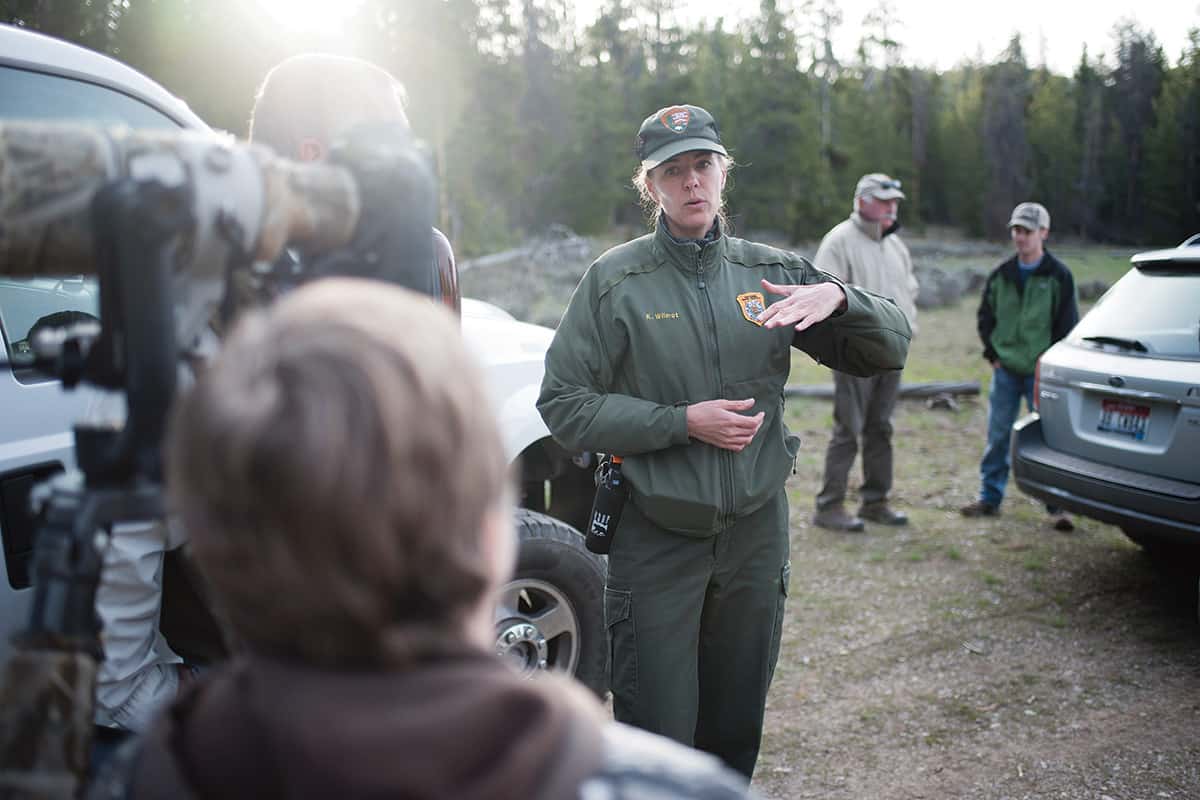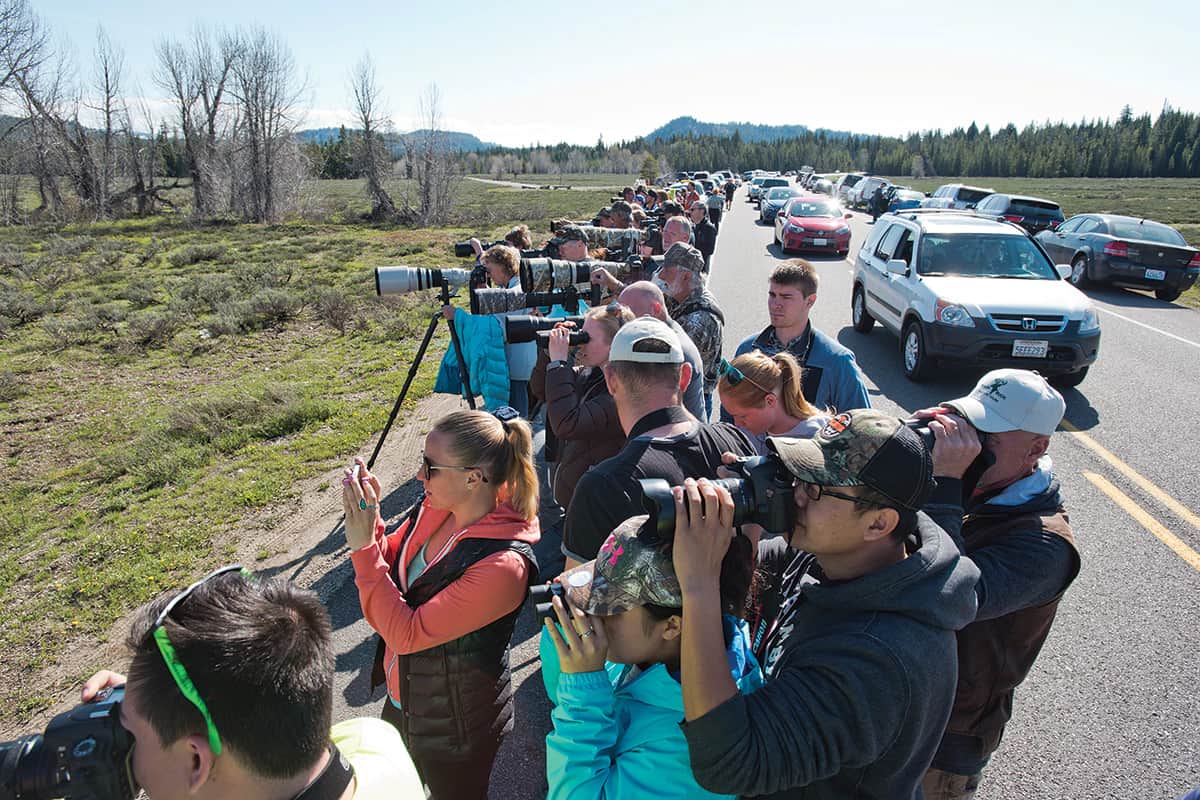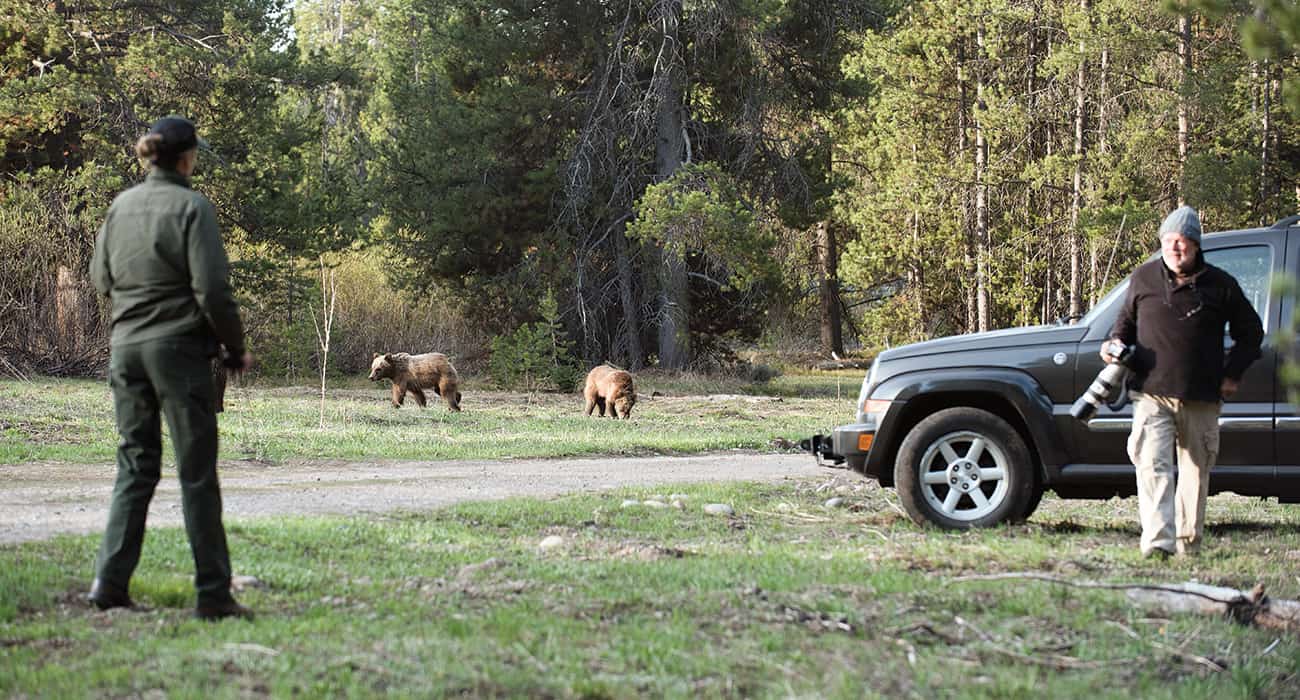Read The
Current Issue
The Crowd Goes Wild
On Grand Teton National Park’s Wildlife Brigade, it’s more about managing people than wildlife.
By Maggie Theodora
Photography by bradly j. boner

A CALL OVER the radio interrupts my interview with two members of Grand Teton National Park’s Wildlife Brigade. Dispatch is reporting a wildlife jam just south of Signal Mountain on the Inner Park Loop Road about three miles from where we are meeting. They jump into their park service SUV, and I follow in my car. We drive for about five miles but don’t see anything. Jolene Mohr and Nancy Adams pull into a turnout and stop. I pull up beside them. “It’s a UTL,” says Mohr, who, along with Adams, is one of the original members of the Wildlife Brigade. “Unable to locate.”
While there was no traffic jam with park visitors out of their cars getting dangerously close to wildlife this time, that’s often not the case, as the Wildlife Brigade usually finds visitors watching anything from a coyote to a grizzly sow with cubs. “Some days we get several calls; some days not,” Adams says. “As we were driving toward this one, I could tell it was breaking up because there was lots of traffic in the opposite direction. We know it’s big when we don’t see any traffic coming at us.”
When Mohr and Adams, and the twenty-some other members of the Wildlife Brigade (both paid and volunteer), aren’t managing roadside wildlife sightings, they patrol the park’s campgrounds, picnic areas, and parking lots to check that bear attractants, like bug spray and food, are properly stored. “The Wildlife Brigade alone has written over 7,000 notes we’ve left at campsites and cars where we’ve found food storage violations,” says Adams, who lives in Salt Lake City and volunteers on the Wildlife Brigade four months a year while she lives in one of the rustic cabins at Colter Bay Village. “We confiscate the stuff in violation of the regulations, too.”
THE WILDLIFE BRIGADE started as a pilot program in 2007. “As grizzly bears started to reoccupy parts of their former range, the park was in a position where it didn’t have the resources to manage bear jams along the road,” says Kate Wilmot, the park’s bear management specialist. Wilmot says the park first realized this in 2004, one year before she arrived. (Previously, Wilmot worked at Glacier and Katmai National Parks, focusing on bears in both places.) A particularly bear jam-y year was 2006, the first year grizzly 399 raised cubs—three of them—within sight of roads in the Oxbow Bend, Willow Flats, and Jackson Lake Lodge areas of the park. (Grizzly 399 did this again in 2011, and the frenzy was compounded by one of her daughters born in 2006, grizzly 610, also being in the area with two cubs of her own.) In 2006, it was law enforcement rangers who were charged with managing bear jams. But, “Rangers were already overextended,” Wilmot says. It was a tough spring, summer, and fall. “That was when we knew we really had to do something to free rangers up to respond to more pressing calls, like heart attacks and accidents,” she says.
In 2007, Wilmot was a seasonal law enforcement ranger in the park and the supervisor of the first two Wildlife Brigade members, Adams and Mohr. Both women were full-time. Adams had been looking for a volunteer opportunity with the NPS. “Kate called and asked if I could be here in two weeks. I said, ‘Yes,’ and I’m still coming up every summer.” Mohr was a seasonal employee working in the park while earning her degree in biology from Metropolitan State University in Denver. Wilmot says the park decided to manage its bears the same way that Yellowstone did: “We’re sharing the same bears, and it’s many of the same visitors in both parks, so it made sense.” Also, data show it works. “It” is managing the crowds watching the bears, rather than the bears themselves.
“Pulling up, they [Park Visitors] were totally low-key, but then they hear ‘bear,’ and the doors of their car are flying open and they’re jumping out. I’m like, ‘I know it’s exciting, but you still have to go and park your car.’ ”
– Jolene Mohr, Wildlife Brigade Member
“Yellowstone initially tried to haze bears away from populated areas,” Wilmot says. “But it wasn’t working, so in 1990 they started to manage the people. Twenty-five years later, that’s what we’re doing. And it’s successful.” Managing people means educating them to be (and helping them be) one hundred yards away from any animal and to make sure bear attractants are properly stored. “We probably took what Yellowstone is doing to another level,” Wilmot says. “But we have a crew doing this now, and in Yellowstone it still falls to the rangers. We’re so much smaller than Yellowstone, too.”
Since its founding, the Wildlife Brigade’s responsibilities have expanded beyond bear jams. “We’ve been called to a hornet’s nest,” Wilmot says. “There are moose jams, elk jams, great gray owl jams, bugling elk jams, fall color jams. There’s always something new.” Mohr says she’s worked grouse jams, fox jams, and pine marten jams.
“Whatever animal is visible seems to grab visitors’ attention,” she says. “I don’t know that there is an underappreciated animal in the park. People are so excited just to see what they can see. I was hiking recently, and there were people going crazy over caterpillars on the trail. I think that anything people can see alive in nature they’re going to stop and want to watch. I’ve seen people taking pictures of magpies. They might be loud and annoying at home, but in the park, they’re something different.”
ADAMS SAYS IT is bear jams that are the best part of the job, and the most challenging. “You’re watching the bear, and you’re trying to get cars moving through, and you’re trying to talk to people and maintain distance from the bear.” Also, “Grizzly bear jams are just insane, especially if there are cubs,” Wilmot says. Mohr adds, “Other animals are exciting, but grizzly bears just bring out a different level of enthusiasm in people. It is so exciting for the public to see bears, especially baby bears. When people driving past see people stopped, they slow down and ask why. When I say, ‘It’s a bear,’ they go really nuts. Pulling up, they were totally low-key, but then they hear ‘bear,’ and the doors of their car are flying open and they’re jumping out. I’m like, ‘I know it’s exciting, but you still have to go and park your car.’ ” While traffic management is secondary to protecting the bears, it is something the Wildlife Brigade does. “We ask people to get all four wheels off the road,” Adams says.
Last year was the first year the Wildlife Brigade used orange traffic cones. “I know they’re ugly,” Wilmot says. “But we’ve found them to be helpful, especially on Moose-Wilson Road.” Because the Wildlife Brigade manages the crowds and not the bears, they sometimes erect brackets on a section of road to allow a bear to cross. “We can tell when a bear wants to cross,” Wilmot says. The brackets create a stretch where there is no traffic or people. “It’s successful maybe 50 percent of the time,” Wilmot says.
When the Wildlife Brigade does interact with a bear is when it is in a developed area—and only when it’s a black bear. “We never do this with grizzlies,” Mohr says. Even then, though, “We follow the bear where it wants to go,” Adams says. “It is going there for a reason. We just want to help it go a little quicker.” And, “Whenever a bear comes to a road, as soon as it hits the pavement, we want to encourage it to go faster.” Wildlife Brigaders do this by clapping, or with light taps on the horn. “In the String Lake Picnic Area, we try to get ahead of it and tell people a bear is coming through and make sure they have all their bear attractants properly stored,” Adams says.
Mohr says she’s found it important to explain to visitors watching the bear that the Wildlife Brigade isn’t chasing it away so they can’t see it. Adams says: “Ninety-nine percent of the time people are cooperative and understand what we’re trying to do. I want people to be exposed to the wildlife in the park so hopefully they will want to conserve and protect it and all of these wonderful natural resources. I love when a bear jam is controlled well enough that we have time to talk to visitors. I always learn something from them, and they have so many questions. It is fun to educate them.”
“You can’t plan your day on this job,” Mohr says. “Also, we enjoy seeing the wildlife as much as everyone else. We feel very lucky that we get to see what we get to see. I think we’ve seen more than a lot of people. We’ve seen grizzly and black bears mating, playing, taking down elk, nursing—all different types of natural bear behavior.”
Natural bear behavior—natural wildlife behavior—is what the Wildlife Brigade is trying to preserve. “We want visitors to enjoy watching these animals, but we’re trying not to habituate these bears so they become problem bears. We don’t want bears to think we’re nice,” Wilmot says.
Interested in volunteering with the Wildlife Brigade? Get in line. “I don’t have much turnover,” Kate Wilmot says. But, “Folks can apply directly to the park.” Also, last summer the park started a group under the Wildlife Brigade, the Lakers. This volunteer group specifically targets String Lake. They’re out there doing food storage information and education for the public, and monitoring parking and resource damage. Email jessica_erwin@nps.gov







